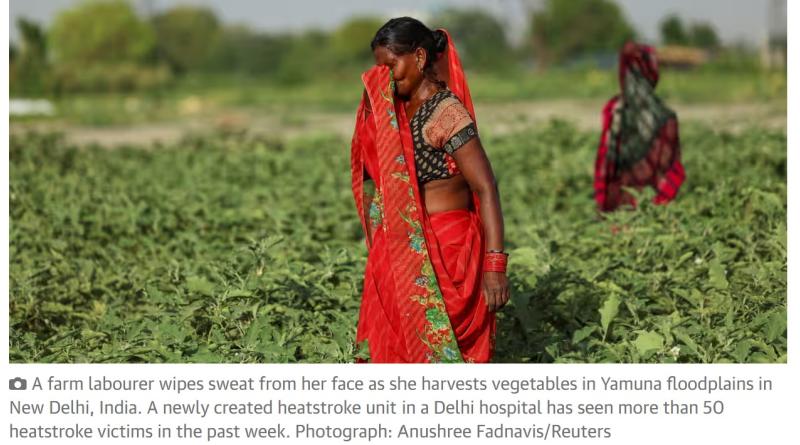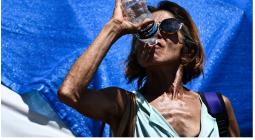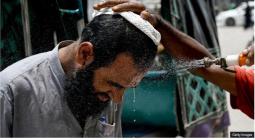‘Time is life’: the Delhi clinic treating the city’s heat stroke victims

As Dr Amlendu Yadav flicks the switch, the large pipe starts gushing water while he shovels ice into the tub. In two minutes, it is full, ready for the next patient in his newly created emergency heatstroke unit at Ram Manohar Lohia hospital in the Indian capital.
The point, he explains, is speed. Heatstroke patients need to be dunked in the bath the moment they arrive at the hospital if they are to stand a chance of surviving.
“Time is life, time is tissue,” said Yadav, head of emergency medicine. “It is imperative to bring a patient’s temperature down fast and this is the quickest way. That’s why the water pipe is big so that the 250 litre tub fills fast and why the ice making machine can make 50 kilos of ice.”
The hospital has seen well over 50 heatstroke patients in the past week. People in Delhi and much of north India have been battered by relentlessly high temperatures of 40 degrees or more every single day since mid-May. March was the hottest month ever recorded. At the start of June, Delhi recorded its highest ever temperature, with two weather stations in the capital reporting temperatures of 49C (120.2F) and 49.1C (120.38F).
According to newspapers that have collated figures, hospitals in Delhi have reported 275 deaths in the heatwave since mid-May. The real figure is believed to be much higher. Many such deaths, overwhelmingly involving poor labourers working outdoors, go unrecorded with neither relatives nor doctors recognising that heatstroke was the cause.
Many Indian people, although accustomed to hot weather, are unaware that being outside in exceptionally high temperatures can damage the kidneys and liver, cause unconsciousness and lead to organ failure.
“They don’t recognise the symptoms so they continue working until they feel confused and in that confusion they don’t seek help and eventually collapse. Usually, we have to put the patients who come to us straight on to the ventilator,” said Dr Seema Wasnik who works with Yadav.
Outside the new unit, the corridors are crowded with people suffering from heatstroke-related ailments. “My husband works crushing stones all day and he began vomiting. I thought it was a viral infection or something he ate,” said Sharmila Devi, standing by her husband’s gurney.
Before the hospital opened the new heatstroke unit, doctors would use cold sponging, ice packs, and cold IV fluids to bring patients’ temperatures down. It was time-consuming and slow. Temperatures of 40C – Yadav has even seen 43C – take time to come down and in this time the organs can be damaged.
The tubs reduce that time to 25 to 30 minutes as the cold water acts on the body’s surface area. While inside the tub, the patient’s vital signs are constantly monitored. Once the temperature comes down, the patient is moved to the ICU.
If more than two patients are admitted, the unit has an inflatable tub – essentially a paddling pool – which has the advantage of being portable and easy to transport to wherever the patient is.
Dileep Mavalankar, a public health specialist who helped to formulate India’s first Heat Action Plan for Ahmedabad in Gujarat, said it was unconscionable that a decade later, hardly any other cities have followed suit.
Delhi devised a plan this year that includes “early warning systems” but there has been no sign of progress during the current heatwave.
Speaking to the Times of India, Mavalankar said the Indian Meteorological Department website predicted a heatwave but the government did little to prepare the public.
“We’ve been breaking heat records now since 2022. Unless we take action now, it will only get worse,” he said.
Some rain brought very slight relief over the weekend – temperatures fell to 37C – but the meteorological department said higher temperatures were set to return.
Human-caused climate breakdown is making every heatwave in the world more intense and more likely to happen. Some, such as the extreme heatwave in western Canada and the US in 2021, would have been all but impossible without global heating.





